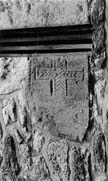Select a site alphabetically from the choices shown in the box below. Alternatively, browse sculptural examples using the Forward/Back buttons.
Chapters for this volume, along with copies of original in-text images, are available here.
Object type: Grave-marker
Measurements: L. c. 65 cm (25.5 in) W. 44 cm (17.25 in) D. 13 cm (5 in)
Stone type: [Inaccessible; appears to be a golden Lincolnshire Limestone but not Ancaster or Barnack types]
Plate numbers in printed volume: Ill. 179
Corpus volume reference: Vol 5 p. 169
(There may be more views or larger images available for this item. Click on the thumbnail image to view.)
A largely complete upright rectangular grave-marker. Its preparation for secondary use appears to have removed or obliterated a cable-moulded border along its present lower edge, which would mean that it was a few centimetres wider. Only two original faces are visible.
A (broad): Decorated with a cable-moulded border that survives only down one edge; its return along the top has been rendered illegible through reuse. Placed centrally is a rectangular cross of type A1, defined by a double incised line. The upper arm abuts the border while the lateral arms are completed short of it and the lower arm fades out in the rough-hewn finish that occupies the lower half of the stone. Within the inner incised line the cross is filled with incised herringbone, chevron or 'wheat-ear' decoration whose arrangement produces a saltire cross at the crossing.
C (broad) and B and D (narrow): Built in.
E (top): The top, visible in the window reveal, is undecorated except for the cabled moulding, and its arris with the other broad face has been removed by an internal window rebate.
This is one of a group of closely similar rectangular markers found with a restricted distribution in Lincoln city and Lindsey (see Chapter V and Table 7A). The rough dressing of the lower half of this stone, like Lincoln Cathedral 2 and Lincoln St Mark 16 and 17 (Ills. 233, 256, 259), show that it was intended to be set earthfast.
One feature, however, sets this piece apart from the group. This is the decorative in-filling of the cross-arms, which recalls the tradition exemplified in the Peterborough area of covers with their elaborate crosses filled with runs of interlace (Fox 1920–1, pl. III). But equally the chevron infilling of the cross has resonances with the patterned effect of double cable moulding on both Lindsey and mid-Kesteven covers. Perhaps, by comparison with the grave-cover at North Kelsey (Ill. 419) for example, it may indicate an eleventh-century rather than earlier date.
A further importance of Glentworth 1, however, lies in its archaeological context, reused in an original architectural feature in a tower of mid to late eleventh-century date (see Glentworth 2–4). This in itself makes implausible Butler's categorisation of it as a cover of the period 1080–1120 (Butler 1961, 148).



